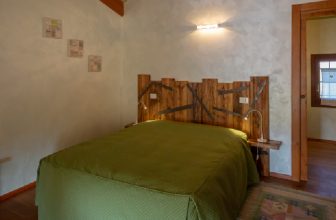How to Decorate a Small Sunroom
Decorating a small sunroom presents both a challenge and an opportunity to showcase one’s creativity and style. When considering how to decorate a small sunroom, the primary focus should always be on maximizing the available space while creating a warm, inviting atmosphere. The significance of space efficiency cannot be overstated, especially in smaller areas where every inch counts.
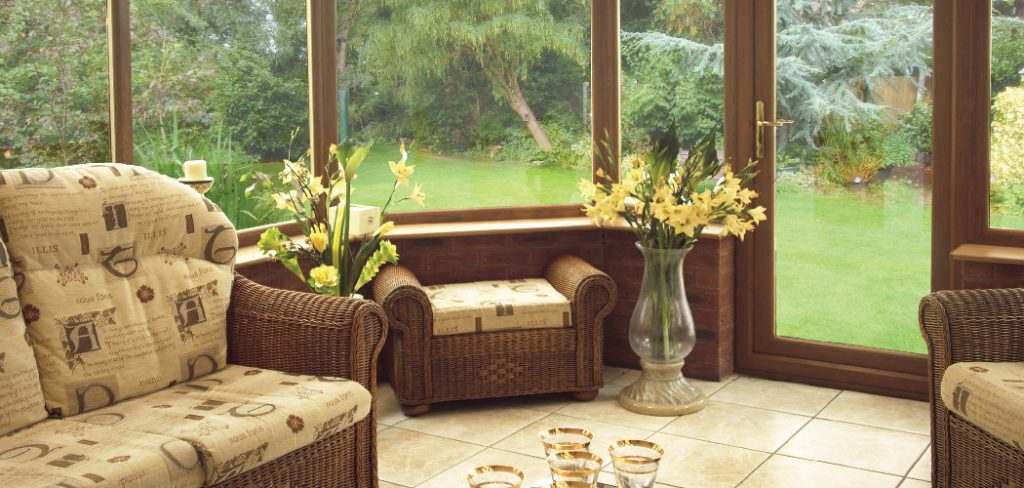
By implementing clever decorating strategies, one can transform a compact sunroom into a beautiful and functional extension of their home. Crafting a sunroom that feels spacious, serene, and sunny through a strategic choice of furniture, color schemes, lighting, and decorative accents is possible. This section will explore various tactics for turning a cramped sunroom into a cozy nook, emphasizing the importance of space utilization and providing an overview of effective decorating approaches to maximize your small sunroom.
Assessing Space and Functionality
Before embarking on the decoration of a small sunroom, it’s crucial to thoroughly assess the space and its functionality. The initial step involves Evaluating Available Space. This requires measuring the room’s dimensions to understand its size and noting any architectural limitations, such as low ceilings or awkwardly placed windows, which could impact your design choices. Sketching a rough floor plan can help visualize the space and assist in furniture arrangement later in the process.
Next, Identifying Functional Needs takes precedence. A sunroom can serve various purposes, from a serene lounge area where one can enjoy a morning coffee to a lively dining space for entertaining guests or even a tranquil home office. Deciding on the primary function of the sunroom guides the furniture selection and layout, ensuring that the space meets your lifestyle requirements.
Lastly, Considering Traffic Flow within the sunroom is essential. The layout should promote easy movement throughout the room without obstructing access to seating, doors, or pathways. Strategic furniture placement can help define clear paths and create a sense of spaciousness.
This is particularly important in small sunrooms where every inch of space matters. Planning for traffic flow also means considering how the sunroom connects to the rest of the house, aiming for a design that facilitates a natural and comfortable transition between areas.
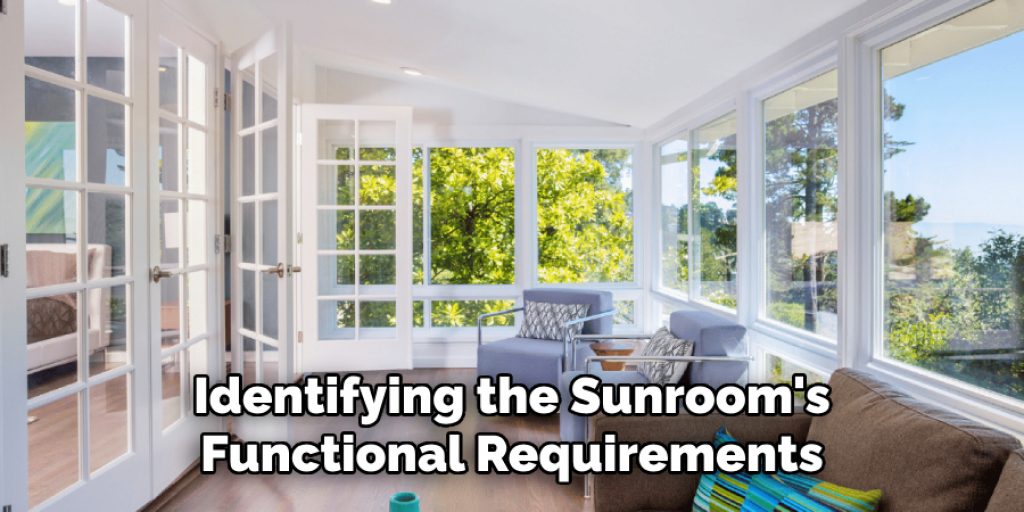
By carefully evaluating the available space, identifying the sunroom’s functional requirements, and planning for optimal traffic flow, you set a strong foundation for decorating your small sunroom. These steps ensure that the space is beautiful, practical, and fully tailored to your needs.
How to Decorate a Small Sunroom: Choosing Suitable Furniture
When it comes to how to decorate a small sunroom, selecting the right furniture plays a pivotal role in balancing functionality with aesthetics. Given the limited space, each piece should be considered carefully to ensure it maximizes utility without compromising the room’s openness and comfort.
A. Opting for Multi-Functional Pieces
Incorporating furniture that serves dual purposes is a smart strategy in a small sunroom. Items like storage ottomans, sleeper sofas, or coffee tables with hidden compartments offer flexibility. These versatile pieces provide additional storage solutions for blankets, books, or seasonal decor, keeping the sunroom clutter-free. For instance, a sleeper sofa accommodates overnight guests without requiring a separate guest room, making it an ideal choice for compact spaces.
B. Prioritizing Scale and Proportion
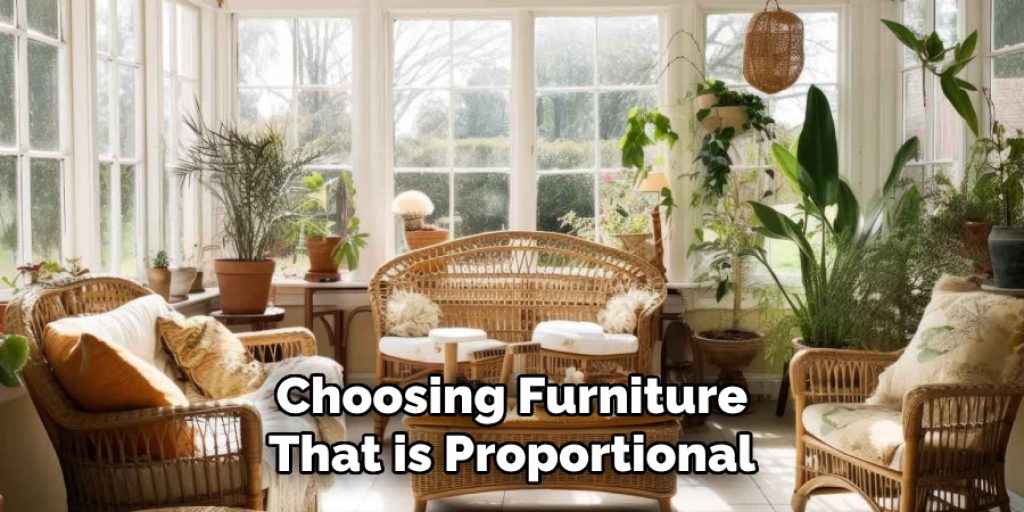
Choosing furniture that is proportional to the size of the sunroom is crucial to avoid overcrowding. Oversized sofas or bulky armchairs can overwhelm a small space, making it feel cramped and leaving little room for movement. Instead, opt for scaled-down furniture that fits comfortably in the room, allowing for adequate circulation space.
For example, a petite, streamlined sofa paired with compact accent chairs can provide ample seating without monopolizing the floor area. This consideration of scale and proportion extends to selecting side tables, chairs, and other accents, ensuring each piece contributes to a harmonious and balanced layout.
C. Embracing Lightweight and Transparent Options
Furniture made from glass, acrylic, or other transparent materials can impart an airy and open feel to a small sunroom. These lightweight options visually consume less space than their opaque counterparts, contributing to an ambiance of spaciousness. An acrylic coffee table or glass-top side tables allow light to pass through, reducing visual clutter and enhancing the room’s overall sense of openness. Additionally, selecting furniture with slender frames and legs can elevate the sense of lightness, minimizing the room’s visual weight.
By focusing on multi-functional furniture, maintaining scale and proportion, and opting for lightweight and transparent pieces, you can create a stylish, comfortable sunroom that feels spacious and welcoming despite its small footprint.
How to Decorate a Small Sunroom: Maximizing Natural Light
Maximizing natural light is crucial in a small sunroom, as it can significantly enhance the sense of space and create a warm, welcoming environment. Natural light not only brightens the room but also promotes a healthy living space by reducing the reliance on artificial lighting during the day. Here are some effective strategies to allow more light into your small sunroom and make the most of it.
A. Keeping Window Treatments Minimal
When it comes to window treatments in a small sunroom, less is more. Using sheer or light-colored curtains or blinds can make a substantial difference in the amount of sunlight entering the room. Sheer materials allow for privacy while letting in abundant natural light, making the space feel airy and open. Light-colored treatments reflect the light, further brightening the room. Avoid heavy, dark fabrics that can absorb light and make the space feel smaller and more confined.
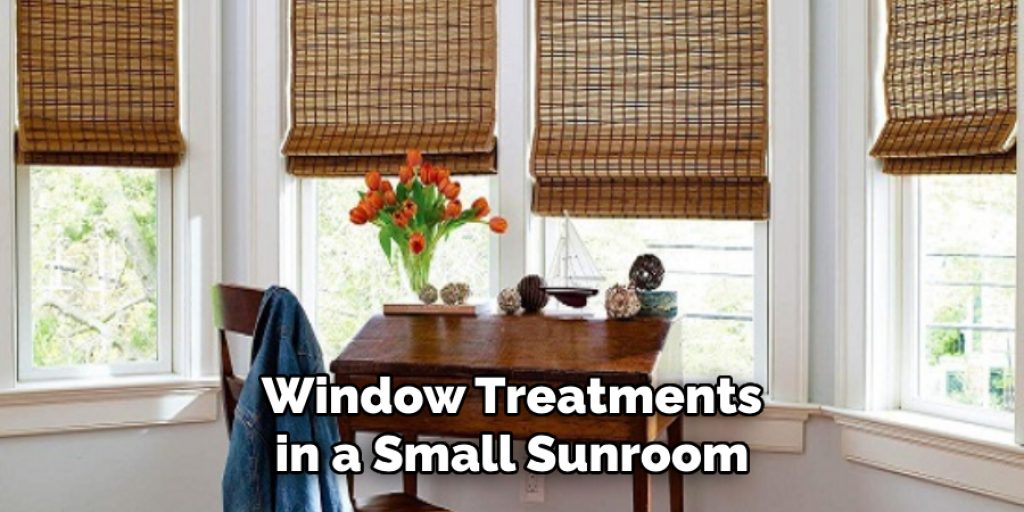
B. Adding Reflective Surfaces
Incorporating reflective surfaces into your sunroom’s decor can amplify natural light significantly. Mirrors strategically placed opposite or adjacent to windows can reflect daylight and spread it throughout the room, making it appear larger and more luminous. Glass tables or metallic accents, such as brass or silver decorative items, also contribute to reflecting light and enhancing the overall brightness of the space. This approach maximizes the natural light available and adds a stylish element to your sunroom’s aesthetic.
C. Utilizing Light-Colored Décor
Opting for light-colored decor can dramatically improve how natural light impacts the room. Light-colored walls, flooring, and furniture upholstery reflect sunlight better than darker colors, contributing to the sunroom’s bright and breezy feel. Consider soft pastels or neutral tones for walls and floors, which can serve as a blank canvas for your décor. Similarly, selecting furniture and cushions in light hues adds to the airy ambiance, making the sunroom feel more open and inviting.
By employing these strategies, you can maximize the natural light in your small sunroom, transforming it into a radiant and cheerful space. This creates a more visually appealing area and fosters a healthier environment by leveraging the benefits of sunlight.
Bringing the Outdoors In
Creating a seamless transition between indoor and outdoor spaces is a cherished design strategy, especially in a small sunroom. This approach not only enhances the visual appeal of the space but also supports well-being by connecting inhabitants with the natural environment. Here are key methods for bringing the outdoors in and making your sunroom a verdant, light-filled oasis.
A. Incorporating Plants
Introducing greenery into your sunroom can transform it into a vibrant, life-filled space. Potted plants, whether large leafy palms or small succulents, add color, texture, and freshness, enhancing the room’s aesthetic and air quality. Hanging planters can effectively utilize vertical space, adding layers of interest without overcrowding.
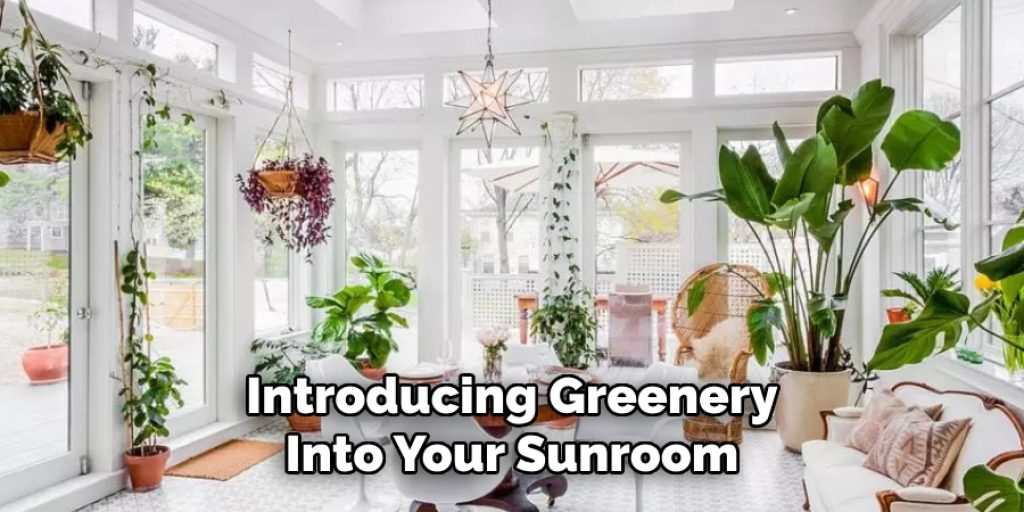
Vertical gardens, too, are a fantastic way to incorporate a variety of plants without sacrificing floor space, creating a living wall that acts as a focal point and a conversation starter. This green integration brings a piece of nature into your home, making the space more inviting and alive.
B. Creating Garden Views
The strategic placement of furniture can significantly impact how the outdoors is perceived from within the sunroom. Arranging seating to face windows or glass doors overlooking a garden, courtyard, or natural vista encourages occupants to engage with the outdoor environment visually.
This setup maximizes the enjoyment of beautiful views and blurs the boundary between the interior and exterior, making the sunroom feel more expansive and connected to nature. Creating sightlines focusing on lush landscapes or colorful flowerbeds can turn the view into a dynamic backdrop for relaxation and entertainment.
C. Installing Bi-Fold or Sliding Doors
Incorporating bi-fold or sliding doors into the sunroom design offers the ultimate blend of indoor comfort and outdoor accessibility. These doors can open fully, effectively removing the barrier between the sunroom and the outdoor patio, garden, or balcony.
This architectural feature facilitates a fluid transition between spaces, making it perfect for entertaining, dining, or simply enjoying a breeze. The ability to open up an entire wall invites natural light and fresh air into the home, enhancing the sensory experience of the sunroom and truly merging the indoors with the outdoors.
By focusing on these strategies—incorporating plants, creating garden views, and installing bi-fold or sliding doors—you can effectively bring the outdoors in, turning your small sunroom into a harmonious extension of the natural world around you.
Adding Cozy Textures and Accents

Creating a cozy and inviting atmosphere in a small sunroom is all about the details. Adding soft textures and warm accents can transform the room into a comfortable retreat, perfect for relaxation or intimate gatherings. Here are some tips to enhance your sunroom with cozy textures and accents.
A. Layering Soft Furnishings
Incorporate throw pillows, blankets, or area rugs in various soft textures to add layers of warmth and comfort to your sunroom. These elements invite you to curl up and relax, making the space more inviting. Choose materials like cotton, wool, or fleece for textiles that feel good against the skin. Layering these items increases the room’s coziness factor and allows for flexibility in styling and comfort as seasons change.
B. Incorporating Natural Materials
Using furniture and décor items made from wood, rattan, or wicker adds a layer of warmth and texture that synthetic materials can’t match. These natural materials bring an earthy, grounded feeling to the space, enhancing the connection to the outdoors. Furniture in natural finishes or with a rustic flair complements the organic feel of the sunroom, making it a serene space to unwind.
C. Introducing Pops of Color
While neutral tones can help create a light and airy feel, adding vibrant cushions, artwork, or accessories can inject personality and energy into the space. Choose colors that inspire happiness and relaxation, such as soft greens, blues, or warm earth tones. These pops of color can also serve as focal points in the room, drawing the eye and adding interest to the overall design. Whether through a brightly colored throw pillow or a piece of wall art, these accents make the sunroom feel uniquely yours and full of life.
By focusing on soft furnishings, natural materials, and vibrant accents, you can create a sunroom that is visually appealing and a cozy haven in your home.
Creating Functional Zones
Designing your sunroom for multifunctional use can significantly enhance its practicality and enjoyment. By creating designated areas for specific activities, you can cater to various needs and interests, from dining and lounging to reading and working. Here’s how to establish these functional zones effectively.
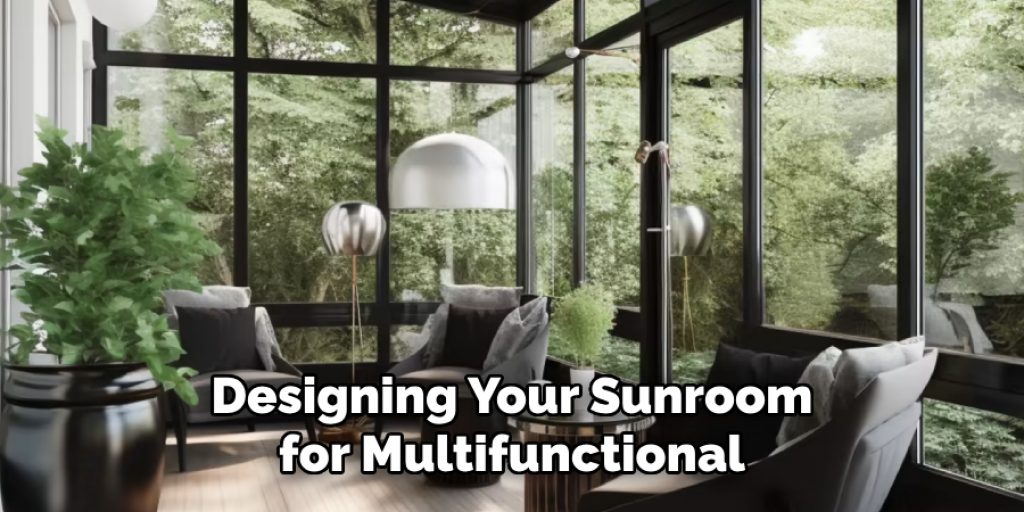
A. Designating Activity Areas
Start by envisioning how you primarily plan to use the space — whether for dining, lounging, reading, or working — then allocate distinct areas for each activity. For example, position a comfortable sofa and coffee table near the best light for a lounge area, a table and chairs in another corner for dining, and a quiet nook with a cozy armchair and side table for reading. This organization allows the sunroom to serve multiple purposes simultaneously without feeling cluttered or chaotic.
B. Utilizing Vertical Space
To keep your sunroom spacious and free from clutter, maximize the use of vertical space. Install shelves, floating cabinets, or wall-mounted organizers to store books, decorative items, or gardening tools. This strategy enhances storage and keeps the floor space open and accessible for other activities. Vertical storage solutions can add to the room’s aesthetic when thoughtfully arranged and selected in styles that complement the sunroom’s overall design.
C. Incorporating Flexible Furniture Arrangements
Using modular furniture or pieces on casters can drastically increase the versatility of your sunroom. Furniture that can be easily moved or rearranged offers the flexibility to adapt the space for different functions, whether you’re hosting a large gathering or needing a change of scenery for your home office setup. For instance, a modular sofa can be split into smaller seats for social gatherings or combined into a single unit for a cozy movie night. This approach to furniture selection ensures your sunroom can seamlessly transition between its designated zones as needed.
Enhancing with Lighting Options
Lighting plays a pivotal role in transforming the ambiance of a small sunroom, making it pivotal for both functionality and aesthetics. Here’s how to illuminate your space effectively:
A. Installing Ambient Lighting

Ambient lighting is the foundation of a sunroom’s lighting plan, providing soft, overall illumination that enhances the room’s natural light. Overhead lighting fixtures, elegant pendant lights, or even a statement chandelier can elevate the decor while ensuring the space is bathed in warm light. This lighting layer is essential for creating a welcoming atmosphere where every element in the room is gently visible, eliminating harsh shadows and creating a sense of spaciousness.
B. Adding Task Lighting
Task lighting is crucial in sunroom areas designated for specific activities such as reading, working, or crafting. Placing table lamps beside seating areas, floor lamps beside reading nooks, or desk lamps in workstations ensures focused illumination, making detailed tasks easier to perform without straining the eyes. This type of lighting can be both functional and a design element, with fixtures chosen to complement the room’s overall style.
C. Incorporating Decorative Lighting
Decorative lighting, such as string lights, lanterns, or LED candles, introduces an element of whimsy and personal flair to the sunroom. Beyond their practical use, these lighting solutions can be strung around windows, draped over furniture, or placed in corners to create a relaxing and magical evening atmosphere. The soft glow from decorative lighting can transform the sunroom into a serene retreat, perfect for unwinding after a long day or hosting intimate gatherings under a canopy of twinkling lights.
By thoughtfully layering ambient, task, and decorative lighting, you can create a multifaceted lighting scheme that makes your sunroom a versatile and enchanting space at any time of day.
Personalizing Your Space
Personalizing your sunroom is the key to transforming it into a true extension of yourself—a place that looks appealing and resonates with your personality and lifestyle.
A. Reflecting Your Style
Integrating elements that mirror your style is crucial when it comes to décor. Whether you’re drawn to the sleek lines of modern design, the eclectic charm of bohemian flair, the soothing palette of coastal themes, or the warmth of traditional aesthetics, ensuring that your sunroom reflects these preferences makes the space truly yours. It’s about blending aesthetics with personal taste to create a sanctuary that feels right at home.
B. Adding Sentimental Value
A sunroom brimming with personal memorabilia, such as family photos, artwork, or souvenirs from travels, adds layers of sentimental value and emotional warmth. These items act as a visual narrative of your life, evoking memories and emotions that brighten the space beyond mere physical light. These personal touches make the sunroom not just a room but a storied space filled with joy and meaning.

C. Making It Functional
Every piece in your sunroom should contribute to its functionality and enhance your enjoyment of the space. This involves selecting decor that isn’t just aesthetically pleasing but also serves a practical purpose or enhances comfort. Think of plush throws for cooler evenings, a selection of your favorite books within arm’s reach, or even an art easel that doubles as a decorative piece. The aim is to marry form and function beautifully, making your sunroom an inviting and useful haven.
Conclusion
In this guide on how to decorate a small sunroom, we’ve navigated through the essentials of maximizing space, amplifying natural light, choosing the right furniture, and personalizing the area to reflect your unique style. We underscored the importance of utilizing vertical space for storage, incorporating flexible furniture arrangements for functionality, and enhancing the ambiance with layered lighting options.
We encourage you to experiment with these ideas, tailoring each to fit your personal needs and preferences. Remember, the goal is to follow design trends and create a space where you feel most at peace and inspired. Whether it’s choosing the right color scheme or selecting the perfect lighting, each detail contributes to making your sunroom a true retreat.
May your newly decorated sunroom provide you with endless enjoyment and relaxation. It’s more than just a room; it’s a sanctuary where memories are made, creativity flows, and tranquility resides. Enjoy every moment in your stylishly decorated sunroom retreat.

